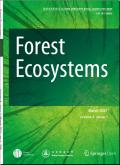利用地面激光扫描评估欧洲山毛榉树枝角度测量
IF 3.8
1区 农林科学
Q1 FORESTRY
引用次数: 0
摘要
枝角是影响林冠截光的重要植物形态特征。然而,由于使用量角器手动测量的耗时性质,对分支角的研究受到限制。然而,地面激光扫描(TLS)为更有效地测量分支角度提供了新的机会。尽管有这种潜力,但验证TLS分支角度测量的研究仍然有限。在这里,我们的目的是利用传统的野外测量,以量角器为参考,评估欧洲山毛榉的手动和自动分支角测量。我们基于四种自动算法(aRchiQSM、TreeQSM、Laplacian、Semantic-Laplacian)对TLS数据的分支角测量精度进行了评估。此外,我们评估了不同的方法,手动分支角度测量在现场。我们的研究基于一个数据集,该数据集包括从欧洲落叶林中的六棵欧洲山毛榉上测量的124个分支角度。我们的研究结果表明,在不同的分支长度位置,TLS数据的手动分支角度测量与参考高度一致(均方根误差,RMSE:[3.57°-4.18°],一致性相关系数,CCC:[0.95−0.97])。自动化算法也与参考文献高度一致,尽管与手动叶片点去除的TLS (RMSE:[9.29°-10.55°],CCC:[0.83−0.86])的手动分支角度测量值相比,RMSE大约是其两倍大。当应用自动木叶分离算法时,四种方法的性能明显下降,仅成功识别出约20个枝角。此外,重要的是要注意,测量位置(分支表面与中心)对分支角测量没有影响。然而,对于弯曲的分支,分支测量长度的选择对分支角度的测量有显著影响。本研究提供了对森林枝角测量的全面认识。研究表明,基于分支角度TLS数据的自动测量方法是在更大尺度上量化分支角度的一种有价值的工具。本文章由计算机程序翻译,如有差异,请以英文原文为准。
Evaluating tree branch angle measurements of European beech using terrestrial laser scanning
Branch angles are an important plant morphological trait affecting light interception within forest canopies. However, studies on branch angles have been limited due to the time-consuming nature of manual measurements using a protractor. Terrestrial laser scanning (TLS), however, provides new opportunities to measure branch angles more efficiently. Despite this potential, studies validating branch angle measurements from TLS have been limited. Here, our aim is to evaluate both manual and automatic branch angle measurements of European beech from TLS data using traditional field-measurements with a protractor as a reference. We evaluated the accuracy of branch angle measurements based on four automated algorithms (aRchiQSM, TreeQSM, Laplacian, Semantic-Laplacian) from TLS data. Additionally, we assessed different ways of manual branch angle measurements in the field. Our study was based on a dataset comprising 124 branch angles measured from six European beech in a European deciduous forest. Our results show that manual branch angle measurements from TLS data are in high agreement with the reference (root-mean-squared error, RMSE: [3.57°–4.18°], concordance correlation coefficient, CCC: [0.95−0.97]) across different branch length positions. Automated algorithms also are in high agreement with the reference although RMSE is approximately twice as large compared to manual branch angle measurements from TLS (RMSE: [9.29°–10.55°], CCC: [0.83−0.86]) with manual leaf points removal. When applying the automatic wood-leaf separation algorithm, the performance of the four methods declined significantly, with only approximately 20 branch angles successfully identified. Moreover, it is important to note that there is no influence of the measurement position (branch surface versus center) for branch angle measurements. However, for curved branches, the selection of branch measurement length significantly impacts the branch angle measurement. This study provides a comprehensive understanding of branch angle measurements in forests. We show that automated measurement methods based on TLS data of branch angles are a valuable tool to quantify branch angles at larger scales.
求助全文
通过发布文献求助,成功后即可免费获取论文全文。
去求助
来源期刊

Forest Ecosystems
Environmental Science-Nature and Landscape Conservation
CiteScore
7.10
自引率
4.90%
发文量
1115
审稿时长
22 days
期刊介绍:
Forest Ecosystems is an open access, peer-reviewed journal publishing scientific communications from any discipline that can provide interesting contributions about the structure and dynamics of "natural" and "domesticated" forest ecosystems, and their services to people. The journal welcomes innovative science as well as application oriented work that will enhance understanding of woody plant communities. Very specific studies are welcome if they are part of a thematic series that provides some holistic perspective that is of general interest.
 求助内容:
求助内容: 应助结果提醒方式:
应助结果提醒方式:


